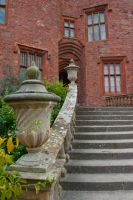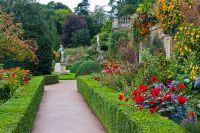
The square tower is thought to be a late Norman keep. A 1668 gateway leads to altered Tudor lodgings and an Edwardian gatehouse. The house is full of memorabilia of India in the time of Clive (his son married a daughter of the house).
This superb house and gardens are set in a wonderful terraced location in the Welsh borderlands, with fabulous views across the valley. In the grounds are steeply terraced gardens planted in the early 18th century, in a style best described as Baroque. Clipped yews and old roses prosper, as well as tender and unusual plants. There are fruit trees on the terraces and an orangery, looking out over the valley and beyond. The views are nothing short of superb.
History of Powis Castle
We do not know precisely when the first castle was built, but there is a very early motte (castle mound) near the present site. The first wooden castle on the current site may have been the work of Owain Cyfeiliog, who died around 1197. Another possibility is Owain's son, Gwenwynwyn (d. 1216).
Gwenwynwyn's son Gruffudd joined with the English crown against Llewelyn ap Gruffudd, with the result that Llewelyn besieged Powis and destroyed the wooden castle in 1274. Gruffudd managed to escape from the sack of Powis and he returned to occupy the building in 1274. It seems likely that Gruffud was responsible for the first stone building on the current site.
In 1587 the castle was purchased by Sir Edward Herbert, beginning a long association of the Herbert family with Powis. Sir Edward began the process of converting what was essentially a medieval fortress, into a comfortable and prestigious stately home.
Sir Edward's son William, the first Lord Powis, supported the king in the Civil War, and Powis was attacked and forced to surrender by Parliamentary troops in 1644. A subsequent William Herbert chose the losing side in the Glorious Revolution, and followed James II into exile abroad. James made him Duke of Powis, the first - and last - Welsh Duke ever. Local Protestant supporters were not impressed, and they ransacked the castle in the Duke's absence.
In the early 19th century Henrietta Herbert married Edward, the son of Robert Clive (Clive of India), and Edward was named Earl of Powis. It is thanks to Edward Clive that Powis today has so many mementoes and fine art brought back from India by Robert Clive. Edward and Henrietta's son changed his name to Herbert, thus re-establishing the long Herbert connection with Powis. The house eventually passed to the National Trust in 1952.
Our verdict:
I can't recall the last time I enjoyed visiting a historic house as much as Powis Castle. The house is marvellous; highly decorated and showy in places, and yet homely and comfortable in others. The staterooms are a mix of fantastically ornate, almost overwhelmingly beautiful showpiece chambers, with quiet and private rooms endowed with a sense of peaceful contemplation. Everywhere the furnishings are of the highest order; with superb portraits and artwork throughout, and wonderful plasterwork ornamentation.
The Clive of India Museum deserves special mention. This is a truly wonderful collection of artefacts associated with Robert Clive, which bring to life the days of the Raj and the British East India Company. The collection is stunning, and of a quality seldom seen in Britain outside large museums. To say I was impressed is an understatement.
By the way, you can amaze your friends and be the life of the party by knowing the correct pronunciation of 'Powis'. It is not, as I incorrectly assumed, pronounced 'Pow - is', but, roughly, 'Poh - is'. So now you know.











 We've 'tagged' this attraction information to help you find related historic attractions and learn more about major time periods mentioned.
We've 'tagged' this attraction information to help you find related historic attractions and learn more about major time periods mentioned.




